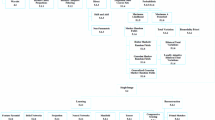Abstract
Digital planes are sets of integer points located between two parallel planes. We present a new algorithm that computes the normal vector of a digital plane given only a predicate “is a point x in the digital plane or not”. In opposition to classical recognition algorithm, this algorithm decides on-the-fly which points to test in order to output at the end the exact surface characteristics of the plane. We present two variants: the H-algorithm, which is purely local, and the R-algorithm which probes further along rays coming out from the local neighborhood tested by the H-algorithm. Both algorithms are shown to output the correct normal to the digital planes if the starting point is a lower leaning point. The worst-case time complexity is in \(O(\omega )\) for the H-algorithm and \(O(\omega \log \omega )\) for the R-algorithm, where \(\omega \) is the arithmetic thickness of the digital plane. In practice, the H-algorithm often outputs a reduced basis of the digital plane while the R-algorithm always returns a reduced basis. Both variants perform much better than the theoretical bound, with an average behavior close to \(O(\log \omega )\). Finally, we show how this algorithm can be used to analyze the geometry of arbitrary digital surfaces, by computing normals and identifying convex, concave or saddle parts of the surface. This paper is an extension of Lachaud et al. (Proceedings of 19th IAPR international conference discrete geometry for computer imagery (DGCI’2016), Nantes, France. Springer, Cham, 2016).










Similar content being viewed by others
References
Berthé, V., Fernique, T.: Brun expansions of stepped surfaces. Discrete Math. 311(7), 521–543 (2011)
Brimkov, V., Coeurjolly, D., Klette, R.: Digital planarity—a review. Discrete Appl. Math. 155(4), 468–495 (2007)
Charrier, E., Buzer, L.: An efficient and quasi linear worst-case time algorithm for digital plane recognition. In: Discrete Geometry for Computer Imagery (DGCI’2008), LNCS, vol. 4992, pp. 346–357. Springer, Berlin (2008)
Charrier, E., Lachaud, J.O.: Maximal planes and multiscale tangential cover of 3d digital objects. In: Proceedings of International Workshop Combinatorial Image Analysis (IWCIA’2011), Lecture Notes in Computer Science, vol. 6636, pp. 132–143. Springer, Berlin (2011)
Chica, A., Williams, J., Andújar, C., Brunet, P., Navazo, I., Rossignac, J., Vinacua, A.: Pressing: smooth isosurfaces with flats from binary grids. Comput. Graph. Forum 27(1), 36–46 (2008)
de Vieilleville, F., Lachaud, J.O., Feschet, F.: Maximal digital straight segments and convergence of discrete geometric estimators. J. Math. Image Vis. 27(2), 471–502 (2007)
Doerksen-Reiter, H., Debled-Rennesson, I.: Convex and concave parts of digital curves. In: Klette, R., Kozera, R., Noakes, L., Weickert, J. (eds.) Geometric Properties for Incomplete Data, Computational Imaging and Vision, vol. 31, pp. 145–160. Springer, Berlin (2006)
Fernique, T.: Generation and recognition of digital planes using multi-dimensional continued fractions. Pattern Recogn. 42(10), 2229–2238 (2009)
Feschet, F.: Canonical representations of discrete curves. Pattern Anal. Appl. 8(1), 84–94 (2005)
Gérard, Y., Debled-Rennesson, I., Zimmermann, P.: An elementary digital plane recognition algorithm. Discrete Appl. Math. 151(1), 169–183 (2005)
Jamet, D., Toutant, J.L.: Minimal arithmetic thickness connecting discrete planes. Discrete Appl. Math. 157(3), 500–509 (2009)
Kerautret, B., Lachaud, J.O.: Meaningful scales detection along digital contours for unsupervised local noise estimation. IEEE Trans. Pattern Anal. Mach. Intell. 43, 2379–2392 (2012)
Kim, C.E., Stojmenović, I.: On the recognition of digital planes in three-dimensional space. Pattern Recogn. Lett. 12(11), 665–669 (1991)
Klette, R., Rosenfeld, A.: Digital straightness—a review. Discrete Appl. Math. 139(1–3), 197–230 (2004)
Klette, R., Sun, H.J.: Digital planar segment based polyhedrization for surface area estimation. In: Proceedings of Visual form 2001, LNCS, vol. 2059, pp. 356–366. Springer, Berlin (2001)
Labbé, S., Reutenauer, C.: A d-dimensional extension of Christoffel words. In: Discrete and Computational Geometry p. 26 (to appear). ArXiv:1404.4021
Lachaud, J.O., Provençal, X., Roussillon, T.: Computation of the normal vector to a digital plane by sampling significant points. In: N. Normand, J. Guédon, F. Autrusseau (eds.) Proceedings of 19th IAPR International Conference Discrete Geometry for Computer Imagery (DGCI’2016), Nantes, France, April 18–20, 2016., pp. 194–205. Springer, Cham (2016)
Lachaud, J.O., Provençal, X., Roussillon, T.: An output-sensitive algorithm to compute the normal vector of a digital plane. Theor. Comput. Sci. 624, 73–88 (2016)
Lachaud, J.O., Vialard, A., de Vieilleville, F.: Fast, accurate and convergent tangent estimation on digital contours. Image Vis. Comput. 25(10), 1572–1587 (2007)
Provot, L., Debled-Rennesson, I.: 3D noisy discrete objects: segmentation and application to smoothing. Pattern Recogn. 42(8), 1626–1636 (2009)
Roussillon, T., Sivignon, I.: Faithful polygonal representation of the convex and concave parts of a digital curve. Pattern Recogn. 44(10–11), 2693–2700 (2011)
Veelaert, P.: Digital planarity of rectangular surface segments. IEEE Trans. Pattern Anal. Mach. Intell. 16(6), 647–652 (1994)
Zrour, R., Kenmochi, Y., Talbot, H., Buzer, L., Hamam, Y., Shimizu, I., Sugimoto, A.: Optimal consensus set for digital line and plane fitting. Int. J. Imaging Syst. Technol. 21(1), 45–57 (2011)
Author information
Authors and Affiliations
Corresponding author
Additional information
This work has been partly funded by DigitalSnow ANR-11-BS02-009 research grant and CoMeDiC ANR-15-CE40-0006 research grant.
Rights and permissions
About this article
Cite this article
Lachaud, JO., Provençal, X. & Roussillon, T. Two Plane-Probing Algorithms for the Computation of the Normal Vector to a Digital Plane. J Math Imaging Vis 59, 23–39 (2017). https://doi.org/10.1007/s10851-017-0704-x
Received:
Accepted:
Published:
Issue Date:
DOI: https://doi.org/10.1007/s10851-017-0704-x




